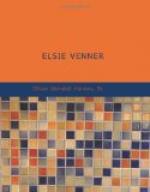and existence uncertain; that virtue was its own reward;
that youth exhaled, like the dewdrop from the flower,
ere the sun had reached its meridian; that life was
o’ershadowed with trials; that the lessons of
virtue instilled by our beloved teachers were to be
our guides through all our future career. The
imagery employed consisted principally of roses, lilies,
birds, clouds, and brooks, with the celebrated comparison
of wayward genius to meteor. Who does not know
the small, slanted, Italian hand of these girls’-compositions,
their stringing together of the good old traditional
copy-book phrases; their occasional gushes of sentiment,
their profound estimates of the world, sounding to
the old folks that read them as the experience of a
bantam pullet’s last-hatched young one with
the chips of its shell on its head would sound to
a Mother Cary’s chicken, who knew the great ocean
with all its typhoons and tornadoes? Yet every
now and then one is liable to be surprised with strange
clairvoyant flashes, that can hardly be explained,
except by the mysterious inspiration which every now
and then seizes a young girl and exalts her intelligence,
just as hysteria in other instances exalts the sensibility,—a
little something of that which made Joan of Arc, and
the Burney girl who prophesied “Evelina,”
and the Davidson sisters. In the midst of these
commonplace exercises which Miss Darley read over
so carefully were two or three that had something of
individual flavor about them, and here and there there
was an image or an epithet which showed the footprint
of a passionate nature, as a fallen scarlet feather
marks the path the wild flamingo has trodden.
The young lady-teacher read them with a certain indifference
of manner, as one reads proofs—noting defects
of detail, but not commonly arrested by the matters
treated of. Even Miss Charlotte Ann Wood’s
poem, beginning—
“How
sweet at evening’s balmy hour,”
did not excite her. She marked the inevitable
false rhyme of Cockney and Yankee beginners, morn
and dawn, and tossed the verses on the pile of papers
she had finished. She was looking over some of
the last of them in a rather listless way,—for
the poor thing was getting sleepy in spite of herself,—when
she came to one which seemed to rouse her attention,
and lifted her drooping lids. She looked at it
a moment before she would touch it. Then she
took hold of it by one corner and slid it off from
the rest. One would have said she was afraid
of it, or had some undefined antipathy which made
it hateful to her. Such odd fancies are common
enough in young persons in her nervous state.
Many of these young people will jump up twenty times
a day and run to dabble the tips of their fingers
in water, after touching the most inoffensive objects.




